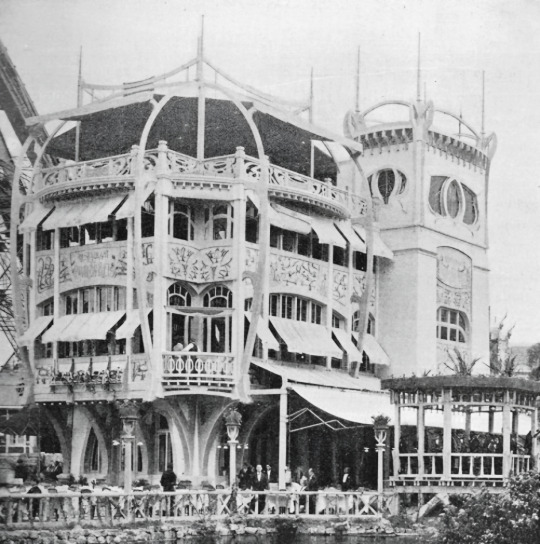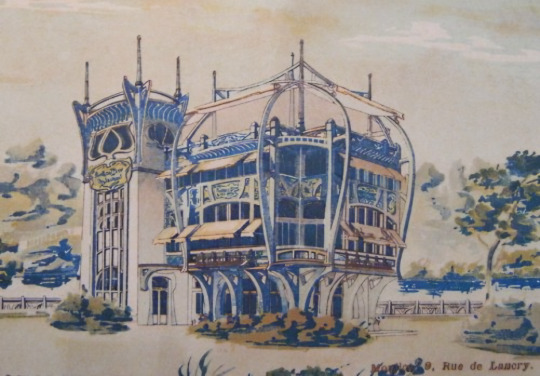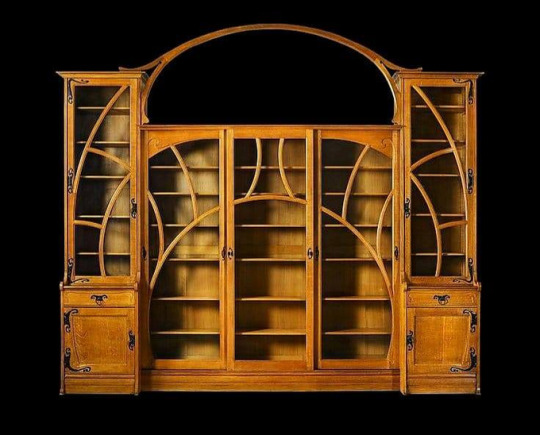#Gustave Serrurier-Bovy
Explore tagged Tumblr posts
Text

Art Nouveau bookcase from 1899 by Belgian architect & furniture designer Gustave Serrurier-Bovy (1858-1910). From ArtNouveauDeco
Blackram Hall: whodunit, murder mystery, hardboiled, pulp, crime, thriller, italian giallo, noir and neo-noir, detectives and serial killers, spy stories, vintage, manor houses, art, life and death.
5 notes
·
View notes
Text



Le Pavillion Bleu ~
“Le pavillion bleu” was an ephemeral luxury restaurant designed by René Dulong and Gustave Serrurier-Bovy for the universal exhibition of 1900 in Paris and located at the foot of the Eiffel tower.
29 notes
·
View notes
Text

Art Nouveau bookcase. By Belgian designer Gustave Serrurier-Bovy. 1898.
2K notes
·
View notes
Text

Art Nouveau Sideboard, part of a dining room ensemble, 1897-1899
Designed by Belgian designer Gustave Serrurier-Bovy (1858-1910).
(Photo source: scalarchives com)
622 notes
·
View notes
Text
















Serrurier-Bovy Un créateur précurseur 1858-1919
Françoise Bigot du Mesnil du Buisson, Etienne du Mesnil du Buisson
éditions Faton, Dijon 2008, 300 pages, 24x31cm, ISBN 978-2-87844-109-3
euro 50,00
email if you want to buy [email protected]
Gustave Serrurier-Bovy est un architecte et décorateur belge né à Liège en 1858 et mort à Anvers en 1910. Il est parmi les premiers représentants de l'Art nouveau en Europe. Cet ouvrage aborde tout d'abord la vie et la formation de Gustave Serrurier, architecte de formation, qui s'engage dans la fabrication et la commercialisation de mobilier dans le magasin de sa femme : Maria Bovy.
12/11/24
7 notes
·
View notes
Text
Masterlist: Artist of the Month
Masterlist
BUY ME A COFFEE
2025
JAN: Alphonse Mucha FEB: John Singer Sargent MAR: Edward Hopper APR: Dragan Bibin MAY: Mary Cassatt JUN: Francisco Goya JUL: Francis Bacon AUG: Victor Horta SEP: Betty Woodman OCT: Yayoi Kusama NOV: Frida Kahlo DEC: Artemisia Gentileschi
2026
JAN: Hilma af Klint FEB: Jules Brunfaut MAR: Berthe Morisot APR: Shiri Phillips MAY: Georgia O'Keeffe JUN: José Manuel Ballester JUL: Charles Rennie Mackintosh AUG: Jenny Saville SEP: Gustave Serrurier-Bovy OCT: Gustav Klimt NOV: Marina Abramovic DEC: Paul Hankar
2027
JAN: Edward Okun FEB: Allan D'Arcangelo MAR: APR: MAY: JUN: JUL: AUG: SEP: OCT: NOV: DEC:
#art#art gallery#artwork#writing#art tag#essay#paintings#art exhibition#art show#art history#essay writing#artists#writers#history#writeblr#writers and poets#writers on tumblr#drawings#creative writing#historical#lecture#academic writing#dark academia#architecture#history lesson#life lessons#learn#painting#drawing#art process
3 notes
·
View notes
Text

I am delighted to participate in some portraits made by Chrystel Mukeba for the exhibition STYLE CONGO, Heritage & Heresy at Civa in Brussels.
Also these images will be part of an installation at Yser station at Brussels in collaboration with Kanal Pompidou.
The works in the exhibition challenge and destabilize the canonical histories and colonial roots of this legacy. By examining the marks of colonization in the city of Brussels and in the Congolese urban landscape, they present a decolonial resignification of private and public spaces, and seek to rewrite the margins of history at the center.
FROM 17/03 to 3/09
ADDRESS CIVA
Hermitagestraat 55 1050 Brussels
Curators Sammy Baloji, Silvia Franceschini, Nikolaus Hirsch, Estelle Lecaille
With the participation of Judith Barry, Rossella Biscotti, Peggy Buth, Ayoh Kré Duchâtelet, Jean Katambayi, Johan Lagae & Paoletta Holst, Chrystel Mukeba, Daniela Ortiz, Ruth Sacks, Traumnovelle
With a selection of works by Victor Horta, Ernest Acker, Victor Bourgeois, Joseph Caluwaers, Jean-Jules Eggericx, Paul Hankar, Georges Hobé, Henry Lacoste, René Pechère, Fernand Petit, René Schoentjes, Gustave Serrurier-Bovy
#lewisossokoh#chrystelmukeba#twentyninestudio#civa#kanal pompidou#style congo#art nouveau#brussels#bruxelles#yser station#congo#sammy baloji#silvia franceschini#nikolaus hirsch#estelle lecaille#judith barry#rossella biscotti#peggy buth#ayoh kré duchâtelet#badi#drucila clement#jean katambayi#johan lagae#chrystel mukeba#daniela ortiz#ruth sacks#paoletta holst#traumnovelle#lewis ossoko h#2023
2 notes
·
View notes
Photo

Ventes aux enchères Paris Gustave SERRURIER-BOVY (1858-1910) Bureau
31 notes
·
View notes
Photo



"Le pavillon bleu” was an ephemeral luxury restaurant designed by René Dulong and Gustave Serrurier-Bovy for the universal exhibition of 1900 in Paris and located at the foot of the Eiffel tower.
848 notes
·
View notes
Photo

Art Nouveau Cabinet-Vitrine Gustave Serrurier-Bovy (Belgian, 1858–1910).
7 notes
·
View notes
Photo

Vase, Gustave Serrurier-Bovy, c. 1905, Minneapolis Institute of Art: Decorative Arts, Textiles and Sculpture
brass frame with glass insert Size: 16 x 6 x 6 in. (40.64 x 15.24 x 15.24 cm) Medium: Brass, glass
https://collections.artsmia.org/art/61835/
14 notes
·
View notes
Text
Summary, Week 4
Lecture 4: Art Nouveau and more
Gilded Age The Industrial Revolution allowed (made inevitable?) the Victorian era’s creation of opulent looking objects in many materials, and many price ranges. The wealth created by manufacturing (and transportation, and industry of all sorts) made a new class of super-rich, not through inheritance but through capitalism and consumption. Many designers and craftsmen appealed to this wealthy market by creating ostentatious luxury goods. The second half of the 19th century also saw tremendous advances in old technologies, the introduction of new technologies, and a gradual shift away from steam power to turbines and electricity. This early era of electricity is often called the Second Industrial Revolution.
• You should know these folks: - Alexander Graham Bell - Thomas Edison (Westinghouse) - George Eastman (Kodak) - Christopher Sholes - I.K. Brunel
• You might like to know: - Elisha Otis (Otis Elevator) - Eadweard Muybridge - Gottlieb Daimler - Karl Benz - Edward C. Moore (Tiffany)
• I showed work by these folks but you are under no obligation to recognize their names: - Cornelius & Co, - Nunns and Clark - Julius Dessoir - Alexander Roux - David Hughes - William Thomson - George Phelps - Charles Elmer Yetman - Christopher Huygens - Niépce Brothers - Joseph Etienne Lenoir - Alphonse Beau de Rochas - Nikolaus Otto - Pavel Ovchinnikov - Benn Pitman - Herter Brothers
I cut these folks out to save time but suspect you might enjoy looking them up: - George Hunzinger
Art Nouveau: – First global style, only “self-concious” style (it was called Art Nouveau while it was happening). – First time designers began thinking in terms of stylizing. – Designs came from significant and meaningful sources, but were inherently fashionable. – The influence of Japanese art changed the way Western artists considered their work (and also an increasing awareness of “other” cultures). – The world began to consider trends and use that information in the design and marketing processes. – Consumption as we now know it is a product of the Art Nouveau sensibility. – Technology, and available materials challenge designers to begin figuring out how to give form to new devices.
• You should know these folks: – Héctor Guimard – Louis Comfort Tiffany – Henry Van de Velde – René Lalique – Émille Gallé – Daum frères – Tiffany & Co. – Gorham Co. – Ernst Hæckel – Victor Horta – Antonio Gaudi – Peter Behrens
• You might like these folks: – Sigfried Bing – Mariano Fortuny – Gustave Serrurier-Bovy – Eugene Gaillard – Otto Wagner – Paulding Farnham (Tiffany) – Lumière Brothers – John Wannamaker – William C. Codman (Gorham) – Leon Kann – Greenwood Pottery – La Pierre Mfg. Co. – William B. Durgin Co. – Charles Rohlfs – Carlo Bugatti
• No reason to know, but how could you not want to: – Loïe Fuller – Buster Brown
• Other names employed in the execution of this lecture: – Alphonse Mucha – George de Feure – Edward Colonna – Cornelius L. J. Begeer – Arthur Silver/Silver Studio – C.F.A. Voysey – William H. Bradley – Frank Hazenplug – Edward Penfield – William Carqueville – Hugnet Frères – Wilhelm Lucas von Cranach – Philippe Wolfers – John T. Curran – Jacob Prytz – Joseph Heinrichs – Candace Wheeler
3 notes
·
View notes
Photo


Favorite items from AC Pocket Camp! I will made my van into a fairy cottage and these two sound perfect : there are Art Nouveau and Art Deco inspired. The lamp seems to be inspired by Ferdinand Preiss (German) and the “Lily of the valley lamp” (but i’m really not sure about this one). And the screen, by the work of Gustave Serrurier-Bovy (Belgian) in the early XX century. This is the aesthetic i’m going for and i certainly will spend all of my precious bells in this project.
#ACPC#my acpc#Pocket Camp#animal crosing pocket camp#nintendo#android apps#items#campground#art inspired#art nouveau#art deco#XX century#early 1900s#history of art#Campsite#arts & crafts#modern art#jugenstil#modernismo#liberty#art history#history of art fact#art in video games#animal crossing#tom nook#vanlife#van interior
4 notes
·
View notes
Photo


Anecdote historique inutile numéro 34: Gustave Serrurier-Bovy est connu dans le pays de liège pour son mobilier art nouveau. Le peï est même exposé au musée d’Orsay. Il est à noter que c’est sa femme Maria Bovy qui ouvre un magasin de décoration « Serrurier-Bovy » et que c’est le nom combiné des deux époux qui restera à la postérité, fait assez rare pour être mentionné. Ce cher Gustave donc devient facteur de meuble. Mais le Gus vient du peuple, alors il aime bien faire de riches meubles en essences précieuses pour les familles nanties du coin, ça gagne bien, mais il a aussi envie de créer des meubles pour le peuple. Alors, Gustave a une idée de génie: sa gamme de produit « artisan » ou « silex » sera à monter soi-même pour limiter les coûts de production. Le mec a inventé le meuble en kit 80 ans avant ikea...
1 note
·
View note
Photo

Vase by Gustave Serrurier-Bovy, Modern and Contemporary Art
Medium: Brass, glass, copper
Purchase, J. Stewart Johnson Gift, 2014 Metropolitan Museum of Art, New York, NY
http://www.metmuseum.org/art/collection/search/638162
5 notes
·
View notes